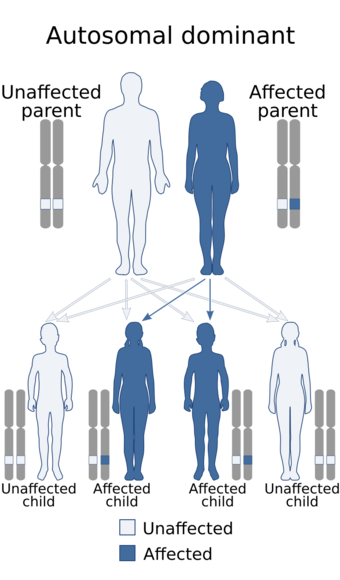Medicine:Heart-hand syndrome, Spanish type
| Heart-hand syndrome, Spanish type | |
|---|---|
| Other names | Heart hand syndrome type 3 (or III), brachydactyly and intraventricular conduction defect, upper limb malformations and congenital cardiac anomalies.[1] |
 | |
| Specialty | Medical genetics |
| Symptoms | Heart and hand anomalies |
| Usual onset | Conception |
| Duration | Life-long |
| Types | This is a type of heart hand syndrome, and doesn't have any subtypes itself. |
| Causes | Autosomal dominant inheritance |
| Diagnostic method | Physical examination, Radiography |
| Prevention | none |
| Prognosis | Ok |
| Frequency | very rare, only 1 family has ever been recorded in medical literature |
| Deaths | - |
Heart-hand syndrome, Spanish type, also known as heart-hand syndrome type 3 or III, is a very rare genetic disorder which is characterized by heart, hand, and sometimes feet abnormalities. It is a type of heart-hand syndrome,[2] a class of genetic disorders characterized by cardiac malformations and hand malformations. Only one family with the disorder has been reported in medical literature.[3]
Description
People with this disorder have symptoms that affect the heart, hands and feet. These include:[4][5][6]
Heart
- Sick sinus
- Bundle branch block
Hands
- Brachydactyly which resembles brachydactyly type C
- Abnormal development of the middle phalanges of the fingers
- Accessory ossicle on the proximal phalange of the index finger.
Feet
- Subtle feet anomalies such as syndactyly
Etimology
This condition was first discovered by Ruiz de la Fuente et al., when they described a 3-generation family from Spain with the symptoms mentioned above. The cardiac defects varied between family members; 3 members had intraventicular conduction defects and 1 had a sick sinus. In this family, the 2nd and 5th fingers were the most severely affected out of all the fingers. Autosomal dominant inheritance was suspected.[7]
References
- ↑ "Heart-hand syndrome, Spanish type". https://rarediseases.org/gard-rare-disease/heart-hand-syndrome-spanish-type/.
- ↑ RESERVED, INSERM US14-- ALL RIGHTS. "Orphanet: Heart hand syndrome type 3" (in en). https://www.orpha.net/consor/cgi-bin/OC_Exp.php?lng=EN&Expert=1342.
- ↑ "OMIM Entry – 140450 - HEART-HAND SYNDROME, SPANISH TYPE" (in en-us). https://omim.org/entry/140450#1.
- ↑ Ruiz de la Fuente, S.; Prieto, F. (1980-07-01). "Heart-hand syndrome" (in en). Human Genetics 55 (1): 43–47. doi:10.1007/BF00329125. ISSN 1432-1203. PMID 7450756. https://doi.org/10.1007/BF00329125.
- ↑ "Heart-hand syndrome, Spanish type - About the Disease - Genetic and Rare Diseases Information Center" (in en). https://rarediseases.info.nih.gov/diseases/2614/heart-hand-syndrome-spanish-type.
- ↑ "Heart-Hand Syndrome, Spanish type" (in en). http://www.dovemed.com/diseases-conditions/heart-hand-syndrome-spanish-type/.
- ↑ Ruiz de la Fuente, S.; Prieto, F. (1980). "Heart-hand syndrome. III. A new syndrome in three generations". Human Genetics 55 (1): 43–47. doi:10.1007/BF00329125. ISSN 0340-6717. PMID 7450756. https://pubmed.ncbi.nlm.nih.gov/7450756/.
 |

